u'中文'
如果中文字符串在Python环境下遇到 UnicodeDecodeError,这是因为.py文件保存的格式有问题。可以在第一行添加注释
# -*- coding: utf-8 -*-
常见的占位符有:
|
%s
|
字符串
|
| %d | 整数 |
| %f | 浮点数 |
| %x | 十六进制整数 |
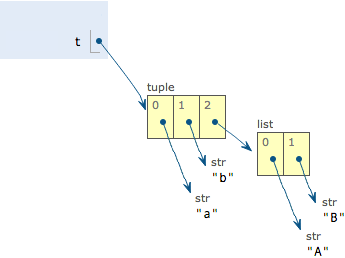
应用场景weekdays = set(['MON', 'TUE', 'WED', 'THU', 'FRI', 'SAT', 'SUN'])更新setadd()
判断可迭代
[1, 4, 9, 16, 25, 36, 49, 64, 81, 100]
写列表生成式时,把要生成的元素x * x放到前面,后面跟for循环,就可以把list创建出来,十分有用,多写几次,很快就可以熟悉这种语法。
for循环后面还可以加上if判断,这样我们就可以筛选出仅偶数的平方:
range()
函数 range(5)生成的序列是从0开始小于5
list()函数可以转换为list
add(key)方法可以添加元素到set中remove(key)方法可以删除元素
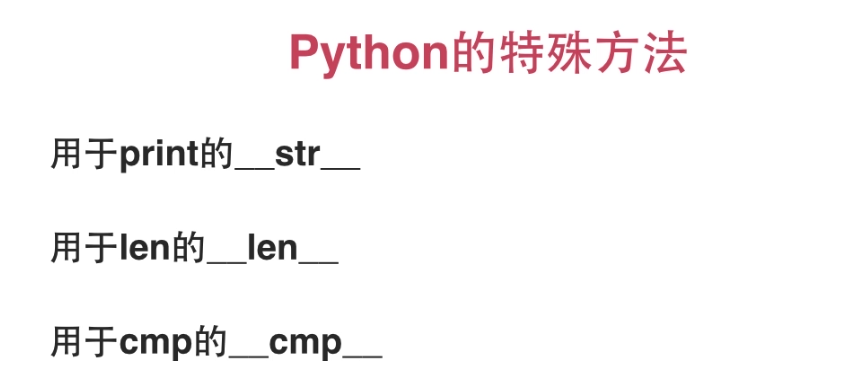
@score.setter---前面的"score"是@property紧跟的下面定义的那个方法的名字,"setter"是关键字,这种“@+方法名字+点+setter”是个固定格式与@property搭配使用。
1.datetime Python处理日期和时间的标准库。 如果仅导入import datetime,则必须引用全名datetime.datetime。now = datetime.now() # 获取当前datetime
dt = datetime(2015, 4, 19, 12, 20) # 用指定日期时间创建datetime
dt.timestamp() # 把datetime转换为timestamp
datetime.strptime()实现
>>> from datetime import datetime, timedelta
>>> now = datetime.now()
>>> now
datetime.datetime(2015, 5, 18, 16, 57, 3, 540997)
>>> now + timedelta(hours=10)
datetime.datetime(2015, 5, 19, 2, 57, 3, 540997)
>>> now - timedelta(days=1)
datetime.datetime(2015, 5, 17, 16, 57, 3, 540997)
>>> now + timedelta(days=2, hours=12)
datetime.datetime(2015, 5, 21, 4, 57, 3, 540997)
摘要算法MD5计算出一个字符串的MD5值:
import hashlib
md5 = hashlib.md5()
md5.update('how to use md5 in python hashlib?'.encode('utf-8'))
print(md5.hexdigest())

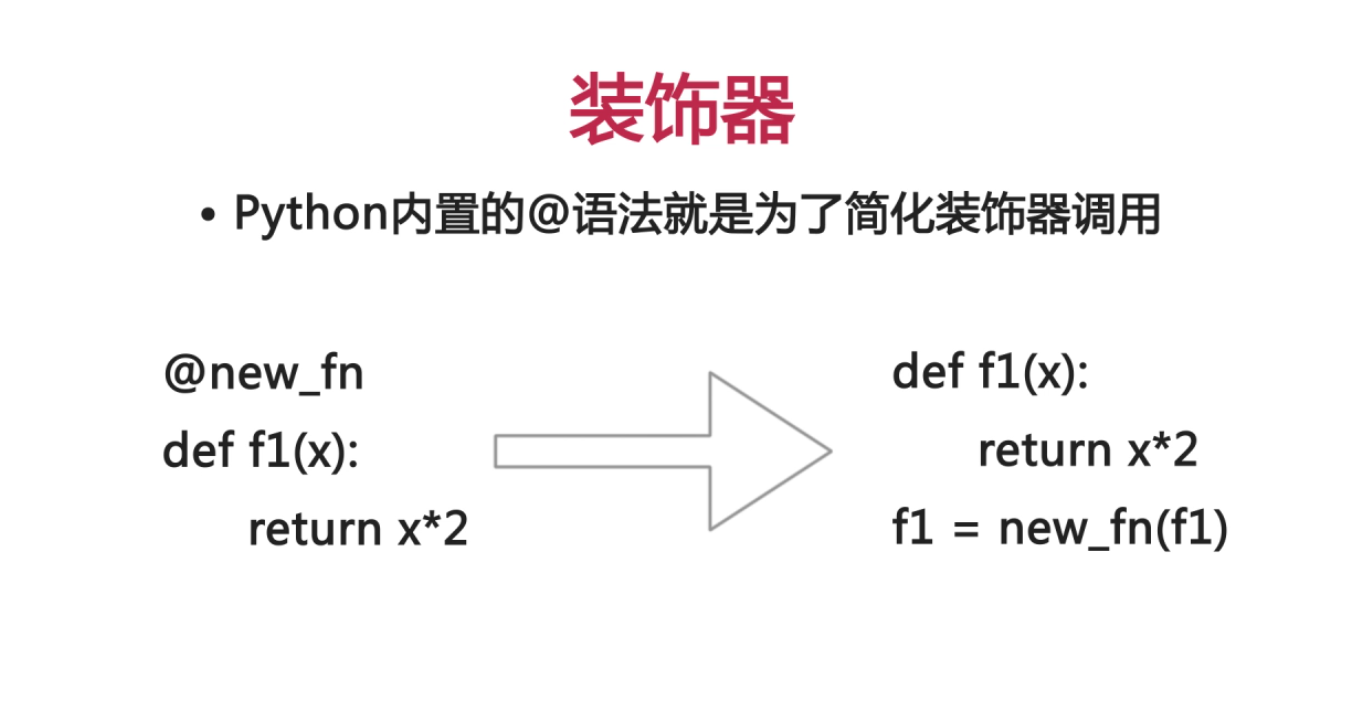

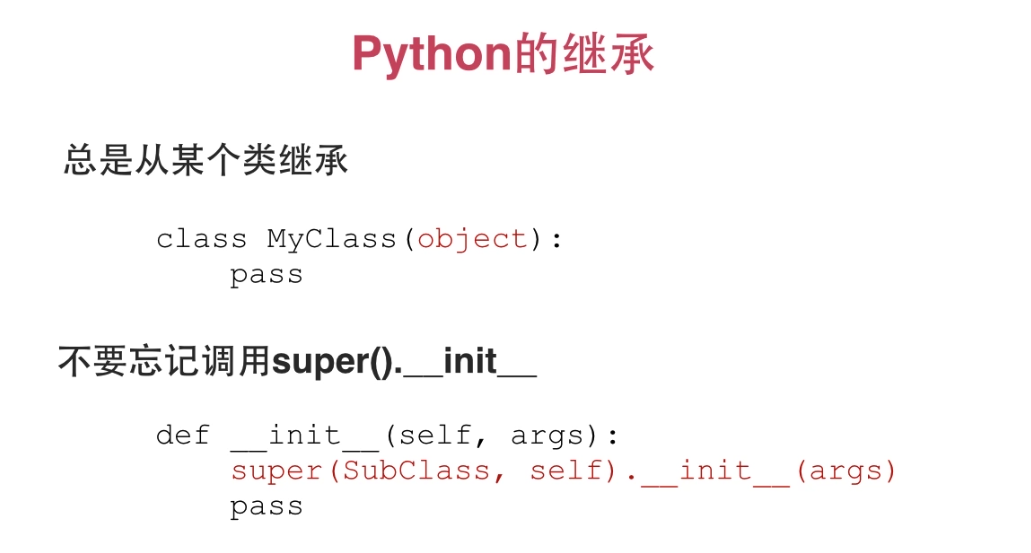
举个例子,Python的网络服务器有TCPServer、UDPServer、UnixStreamServer、UnixDatagramServer,而服务器运行模式有 多进程ForkingMixin 和 多线程ThreadingMixin两种。
要创建多进程模式的 TCPServer:
class MyTCPServer(TCPServer, ForkingMixin)
pass
要创建多线程模式的 UDPServer:
class MyUDPServer(UDPServer, ThreadingMixin):
pass
如果没有多重继承,要实现上述所有可能的组合需要 4x2=8 个子类。
断言
凡是用print()来辅助查看的地方,都可以用断言(assert)来替代:
IndexError: list index out of range
File "index.py", line 11, in <module>
print d['Paul']
KeyError: 'Paul'
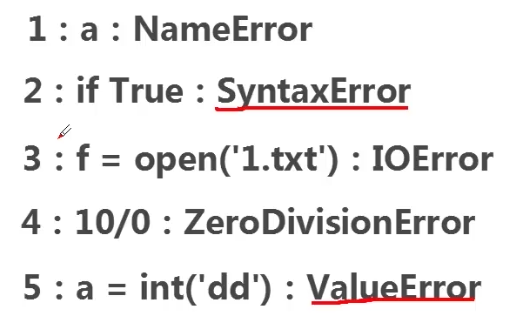


with
语句来自动帮我们调用
close()
方法:
with
open(
'/path/to/file'
,
'r'
)
as
f:
在正则表达式中,如果直接给出字符,就是精确匹配。用\d可以匹配一个数字,\w可以匹配一个字母或数字,所以:
-
'00\d'可以匹配'007',但无法匹配'00A'; -
'\d\d\d'可以匹配'010'; -
'\w\w\d'可以匹配'py3';
.可以匹配任意字符,所以:
'py.'可以匹配'pyc'、'pyo'、'py!'等等。
要匹配变长的字符,在正则表达式中,用*表示任意个字符(包括0个),用+表示至少一个字符,用?表示0个或1个字符,用{n}表示n个字符,用{n,m}表示n-m个字符:
来看一个复杂的例子:\d{3}\s+\d{3,8}。
我们来从左到右解读一下:
-
\d{3}表示匹配3个数字,例如'010'; -
\s可以匹配一个空格(也包括Tab等空白符),所以\s+表示至少有一个空格,例如匹配' ',' '等; -
\d{3,8}表示3-8个数字,例如'1234567'。
因此我们强烈建议使用Python的r前缀,就不用考虑转义的问题了:
s = r'ABC\-001'# Python的字符串# 对应的正则表达式字符串不变:# 'ABC\-001'先看看如何判断正则表达式是否匹配:
>>>
import
re
match()方法判断是否匹配,如果匹配成功,返回一个Match对象,否则返回None。常见的判断方法就是:
test =
'用户输入的字符串'
if
re.match(
r'正则表达式'
, test):
| 解析器 | 使用方法 | 优势 | 劣势 |
|---|---|---|---|
| Python标准库 | BeautifulSoup(markup, “html.parser”) |
|
|
| lxml HTML 解析器 | BeautifulSoup(markup, “lxml”) |
|
|
| lxml XML 解析器 | BeautifulSoup(markup, [“lxml”, “xml”])BeautifulSoup(markup, “xml”) |
|
|
| html5lib | BeautifulSoup(markup, “html5lib”) |
|
|
四大对象种类
Tag(通俗点讲就是 HTML 中的一个个标签)NavigableStringBeautifulSoupComment
|
1
2
|
print
soup
.
title
#<title>The Dormouse's story</title>
|
|
1
2
|
print
soup
.
p
.
string
#The Dormouse's story
|
遍历文档树
.contents
tag 的 .content 属性可以将tag的子节点以列表的方式输出,我们可以用列表索引来获取它的某一个元素
|
1
2
|
print
soup
.
head
.
contents
[
0
]
#<title>The Dormouse's story</title>
|
|
1
2
|
for
child
in
soup
.
body
.
children
:
print
child
|
|
1
2
3
4
5
|
<
p
class
=
"title"
name
=
"dromouse"
>
<
b
>
The
Dormouse'
s
story
<
/
b
>
<
/
p
>
<
p
class
=
"story"
>
Once
upon
a
time
there
were
three
little
sisters
;
and
their
names
were
<
a
class
=
"sister"
href
=
"http://example.com/elsie"
id
=
"link1"
>
<
!
--
Elsie
--
>
<
/
a
>
,
<
a
class
=
"sister"
href
=
"http://example.com/lacie"
id
=
"link2"
>
Lacie
<
/
a
>
and
|
.stripped_strings 可以去除多余空白内容
|
1
2
3
4
5
6
7
8
9
10
11
12
|
for
string
in
soup
.
stripped_strings
:
print
(
repr
(
string
)
)
# u"The Dormouse's story"
# u"The Dormouse's story"
# u'Once upon a time there were three little sisters; and their names were'
# u'Elsie'
# u','
# u'Lacie'
# u'and'
# u'Tillie'
# u';\nand they lived at the bottom of a well.'
# u'...'
|
|
1
2
3
|
p
=
soup
.
p
print
p
.
parent
.
name
#body
|
搜索文档树
find_all( name , attrs , recursive , text , **kwargs )
name 参数可以查找所有名字为 name 的tag
下面方法校验了当前元素,如果包含 class 属性却不包含 id 属性,那么将返回 True:
|
1
2
|
def
has_class_but_no_id
(
tag
)
:
return
tag
.
has_attr
(
'class'
)
and
not
tag
.
has_attr
(
'id'
)
|
将这个方法作为参数传入 find_all() 方法,将得到所有<p>标签:
|
1
2
3
4
|
soup
.
find_all
(
has_class_but_no_id
)
# [<p class="title"><b>The Dormouse's story</b></p>,
# <p class="story">Once upon a time there were...</p>,
# <p class="story">...</p>]
|
|
1
2
|
soup
.
find_all
(
id
=
'link2'
)
# [<a class="sister" href="http://example.com/lacie" id="link2">Lacie</a>]
|
如果传入 href 参数,Beautiful Soup会搜索每个tag的”href”属性
|
1
2
|
soup
.
find_all
(
href
=
re
.
compile
(
"elsie"
)
)
# [<a class="sister" href="http://example.com/elsie" id="link1">Elsie</a>]
|
使用多个指定名字的参数可以同时过滤tag的多个属性
|
1
2
|
soup
.
find_all
(
href
=
re
.
compile
(
"elsie"
)
,
id
=
'link1'
)
# [<a class="sister" href="http://example.com/elsie" id="link1">three</a>]
|
在这里我们想用 class 过滤,不过 class 是 python 的关键词,这怎么办?加个下划线就可以
|
1
2
3
4
|
soup
.
find_all
(
"a"
,
class_
=
"sister"
)
# [<a class="sister" href="http://example.com/elsie" id="link1">Elsie</a>,
# <a class="sister" href="http://example.com/lacie" id="link2">Lacie</a>,
# <a class="sister" href="http://example.com/tillie" id="link3">Tillie</a>]
|
有些tag属性在搜索不能使用,比如HTML5中的 data-* 属性
|
1
2
3
|
data_soup
=
BeautifulSoup
(
'<div data-foo="value">foo!</div>'
)
data_soup
.
find_all
(
data
-
foo
=
"value"
)
# SyntaxError: keyword can't be an expression
|
但是可以通过 find_all() 方法的 attrs 参数定义一个字典参数来搜索包含特殊属性的tag
|
1
2
|
data_soup
.
find_all
(
attrs
=
{
"data-foo"
:
"value"
}
)
# [<div data-foo="value">foo!</div>]
|
|
1
2
3
|
soup
.
find_all
(
"a"
,
limit
=
2
)
# [<a class="sister" href="http://example.com/elsie" id="link1">Elsie</a>,
# <a class="sister" href="http://example.com/lacie" id="link2">Lacie</a>]
|
(2)find( name , attrs , recursive , text , **kwargs )
它与 find_all() 方法唯一的区别是 find_all() 方法的返回结果是值包含一个元素的列表,而 find() 方法直接返回结果
CSS选择器
[x * x for x in range(1, 11) if x % 2 == 0]
传入**kw 即可传入任意数量的参数,并通过 setattr() 绑定属性,iteritems()用于字典kw的遍历
参考代码:
class Person(object): def __init__(self, name, gender, **kw): self.name = name self.gender = gender for k, v in kw.iteritems(): setattr(self, k, v) p = Person('Bob', 'Male', age=18, course='Python') print p.age print p.course























 1万+
1万+

 被折叠的 条评论
为什么被折叠?
被折叠的 条评论
为什么被折叠?








